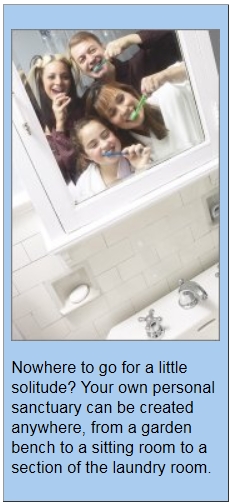A Space of Your Own:
The Need for Solitude...
and How to Set Up Your Personal Space
©2016 Health Realizations, Inc. Update
If you've ever been stuck on a crowded elevator, shared a bathroom with more than one person, or had someone bash their shoulder into you while walking down the street, you know about personal space, and the immense value it holds.
 Whether in public and among strangers or in your
own home with your family, having a space of your
own, and not allowing its boundaries to be
overstepped, is important for your very sanity.
Whether in public and among strangers or in your
own home with your family, having a space of your
own, and not allowing its boundaries to be
overstepped, is important for your very sanity.
"The violation of personal space increases tension levels enormously," says Robert Sommer, a psychologist at the University of California-Davis and author of the book Personal Space.
Through his research, which included purposely sitting or standing too close to strangers in parks and libraries, he concluded that violating personal space " ... provokes cathartic responses. They begin tapping their toes, they pull at their hair, they get completely rigid. It may not trigger a full-blown schizophrenic episode, but it's clearly not good for your health."
Proxemics: The Four Levels of Personal Space
Anthropologist Edward T. Hall created the field known person's use of space. According to Hall, people have varying degrees of personal space that they deem acceptable for certain behaviors. These are:
- The Intimate Zone: 18 inches or less around your body, used for whispering and embracing.
- The Personal Zone: 18 inches to 4 feet from your body, used for conversing with close friends.
- The Social Zone: 4 feet to 10 feet from your body, used for conversing with acquaintances.
- The Public Zone: 10 to 25 feet from your body, used for interacting with strangers.
"People use avoidance responses," Sommer says. "You get the New Yorker non-person phenomenon. They just shut down."
Meanwhile, many studies have found that invading a person's personal space creates stress, which is responsible for 75 percent to 90 percent of doctor visits, according to the American Institute for Stress.
Over time, stress can become chronic and has been linked to a host of major illnesses, including heart disease, cancer, depression, autoimmune diseases and reproductive problems, along with more minor maladies like stomach upset, back pain, headaches and fatigue.
So if your space is constantly being invaded, and you have no place to go for a moment of solitude, your mental and physical health could be at risk. Your relationships can also suffer if neither partner has room to grow independently in a space they can call their own. Here are some common scenarios in which space invasion is a real problem:
- At the office, you have to work at a different desk each day because no permanent space has been assigned to you
- There is no room in your home where you feel you can have privacy
- Even in "your" space, such as your bedroom, people barge in and out often
- You travel regularly and must sleep in a different hotel room every night
 "There's less stress in a home if each person in the family
has a spot that's just theirs: the workshop in the garage, a
chair in the corner, a closet for a child" says Jackie Craven, a
house restorer in Schenectady, N.Y., and author of "The
Strees-Free Home".
"There's less stress in a home if each person in the family
has a spot that's just theirs: the workshop in the garage, a
chair in the corner, a closet for a child" says Jackie Craven, a
house restorer in Schenectady, N.Y., and author of "The
Strees-Free Home".
The first step is finding a space for yourself. This can be a laundry room, a basement, a spare room, or even a garden. Any place where you feel comfortable. In Chris Casson Madden's book "A Room of Her Own: Women's Personal Spaces", women share their ideas for creating personal spaces, which include a fabric-filled loft, a sitting room, a rainbow-colored Tibetan tent, a pavilion, an office, and a bedroom, echoing the fact that your personal space can be anywhere.
Next, "delineate the space with a curtain, screen, shelving, tall plant, different color paint, or just lighting. Each person puts in their space what's important to them," Craven says.
In other words, if you love nature, your space would likely include natural things that bring warmth and remind you of the outdoors, such as stones or seashells you've found, plants, and large windows, or perhaps the space would be outdoors. On a side note, nature in general has been proven to induce calm, so even something as simple as putting out fruit in a bowl or using bamboo window shades can help you relax.
If you travel often and have trouble feeling at home while on the road, you can take your personal space with you simply by carrying a few of these special objects with you.
Make Your Personal Space "Yours"
Another important aspect in creating your sanctuary is including personal items that have meaning to you, such as photographs, favorite books, candles, a favorite chair -- anything you love and find calming. (But be careful not to clutter up the space too much, which can defeat the purpose.)
Meanwhile, pay attention to the color of the room. Neutral tones are known to be calming, earth tones warming and grounding and cool tones like blues, greens and lavender restful.
"The classic advice for stress-free rooms encourages monochromatic, earth-toned or blue-green color plans," Craven says.
Finally, choose a space that is comfortable and quiet. If you're buying new furniture for the room, be sure to pick something that you'll love lounging on. Or, if your sanctuary is your bathroom, think about adding some fluffy rugs or soft fabrics.
To keep things quiet, choose a space that's away from the hustle and bustle of the rest of the house, and add some thick carpeting, solid doors and double-pane windows.
Finally, use a white noise machine or water fountain for some positive noise, and revel in the pleasant noises around you, such as birds chirping through an open window.
Sources
Salon.com
Natural Health Magazine
Natural Health Magazine
Editor's note: This article was originally published on March 15th 2016

